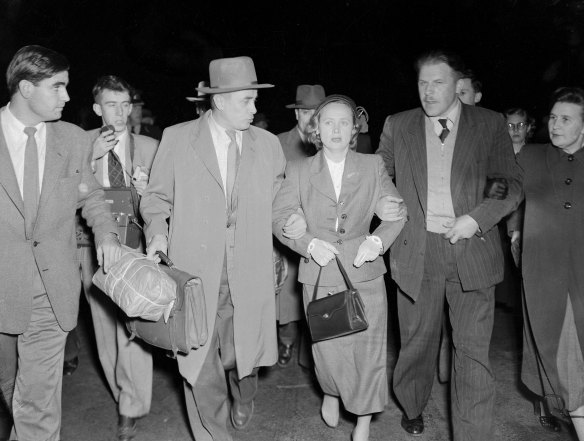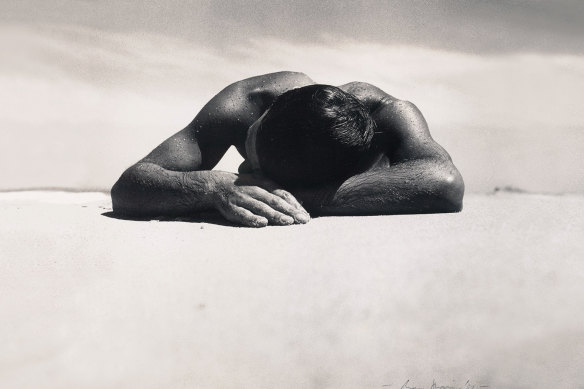- Exclusive
- Culture
- Art & design
- Photography
This was published 3 months ago
Rare photos showing Sydney’s Cold War history go on display
By Helen Pitt
For many Australians, the striking image of Evdokia Petrov being escorted by two burly KGB agents onto a plane to fly back to the Soviet Union is etched in their memories even 70 years on.
About 1000 angry anti-communist protesters descended on Sydney airport in April 1954, while police, security officers, and airport officials fought for eight minutes to get Petrov on to the plane’s gangway.

Evdokia Petrov being tightly gripped by a Russian bodyguard leading her across the tarmac at Mascot in 1954. Credit: R L Stewart
She and husband Vladimir, both Soviet spies masquerading as diplomats, would later be released in Darwin and seek asylum in Australia.
What became known as the Petrov Affair captured the imagination of the nation.
A month after the dramatic airport scene, University of Sydney students recreated it in a float in their annual parade, known as the commemoration day march, in the streets of Sydney.
Photographer Max Dupain was on the ground to capture the moment, snapping an image that is part of a new exhibition to open at the University of Sydney’s Chau Chak Wing Museum, on August 9.

Max Dupain’s most famous photo, Sunbaker.Credit: State Library of NSW
While he may be best known for snapping the head and shoulders of Harold Salvage, lying on the sand at Culburra Beach on the NSW south coast, in his famous shot the Sunbaker, between commercial work Dupain spent a lot of time on campus at Australia’s oldest university.
Although a graduate of the National Art School (then known as East Sydney Tech), Dupain knew the university well, having worked there as an architectural photographer shooting many of the university’s then new, modernist buildings.
He not only took candid snaps of students, but also captured the more relaxed mood when more women started attending university post-World War II, said curator Ann Stephen.
“Dupain documents all aspects of uni life from vet science students working with horses, to dances at the Union’s Holme Building with girls in their gowns through to politics and protests,” Stephen said.
The photos capture the emerging anti-nuclear protest movement, after the university’s most famous academic Professor Harry Messel controversially formed the university’s Nuclear Research Foundation in 1953, and students adorned an old jalopy to satirise his scheme.
“The following month after the Petrovs had been exposed, you have the students re-enacting the infamous moment when Mrs Petrov is the dragged along the tarmac by two big KGB men. It’s a pretty hot moment in the Cold War [and] these photos are a fascinating time capsule of Cold War issues,” Stephen said.
The university’s Russian history expert Professor Emeritus Graeme Gill said Dupain captured the fear of Soviet spies and communism in the 1950s.
“In 1951 Menzies tried to ban communism in a referendum and it failed. When Petrov defected as the KGB man in Australia it fed into the general fear that communists were out there to subvert the country. You’d expect uni students to be left-wing, but this re-enactment was clearly an anti-Soviet statement on the part of the students,” he said.
Student Life: Max Dupain at the University of Sydney runs until August 2025.
The Booklist is a weekly newsletter for book lovers from books editor Jason Steger. Get it delivered every Friday.